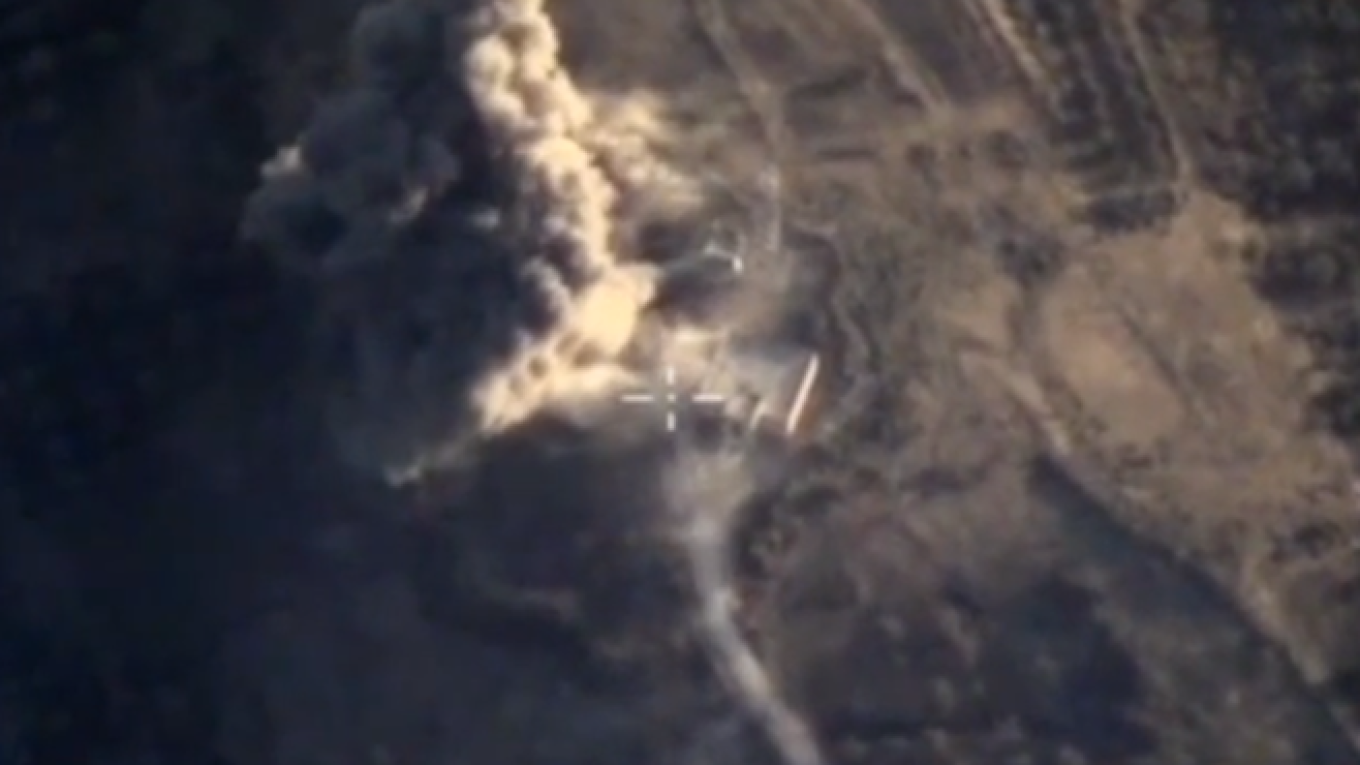Disarray among the Islamic State terrorist organization has prompted a decrease in the number of sorties being flown by Russian jets in Syria, the Defense Ministry said Thursday.
Russian planes flew 33 missions during the last 24 hours, according to the Defense Ministry, a sharp drop from the high of 88 sorties recorded just two days earlier.
“The intensity of flights by our military aircraft has fallen slightly during the last 24 hours. This is because the result of an active offensive by Syrian forces has been the transformation of the line of contact with the Islamic State terrorist group,” the Defense Ministry said in a statement.
The scaling down of the aerial bombardment came amid reports that the Syrian army was launching fresh attacks against rebel groups that have wrested much of Syria from President Bashar Assad's control since the start of the country's bloody civil war four years ago.
Experts said that in recent days, Russian planes in Syria have come close to the intensity of missions flown by Western jets during the bombing of Serbia in 1999.
“If there is an offensive, there are new targets and successes need to be developed,” said Yevgeny Buzhinsky, a former Russian lieutenant general now at the PIR Center, a Moscow-based think tank.
On the first day of Russian air strikes in Syria, jets flew 24 sorties: a daily total that did not change much for the first week of attacks. But the apparent success of the bombings appeared to push Russia to increase the intensity, and on Oct. 7, cruise missiles were launched from Russian warships in the Caspian Sea and the tempo of sorties was stepped up.
“The intensity of strikes will grow,” Defense Minister Sergei Shoigu told President Vladimir Putin that day.
In the second week of bombing, the daily sortie tally was usually three times higher than the first week — Thursday's number of 33 was the only time the figure dipped below 40.
Putin said when he announced the beginning of air strikes that they would be ceased once the Syrian army went on the offensive.
Any explanation for the ebb and flow of the Russian air strikes is likely to be found by studying the situation on the ground, according to a defense expert and former U.S. soldier who requested anonymity to speak freely.
“Maybe this is a short-term offensive,” he said.
Assad's troops launched an offensive Thursday that looks set to push toward strategic rebel-held towns north of the city of Homs, the Reuters news agency reported. There have also been reports that Damascus has recruited Iranian fighters to help in an attack on the port city of Aleppo.
Western officials have said that Russia is targeting moderate insurgent groups in an attempt to bolster Assad's position. Russia insists it is only hitting Islamic State infrastructure and equipment.
“The [rebel] fighters are retreating and trying to equip new positions and change existing logistics systems for the delivery of ammunition, weapons and materials,” Russia's Defense Ministry said Thursday in a statement about the situation.
State-owned Russian media has been keen to portray the success of Russian air strikes. Within days of the beginning of the operation, state television channels claimed that there was “panic" among Islamic State militants, while details of a Syrian army ground offensive have been given significant airtime.
Russia's air power in Syria is only big enough to allow Assad's forces to make modest tactical gains, according to experts, who also said that without more information on the number of pilots or knowing how many of the sorties were air strikes and how many were reconnaissance missions, it is difficult to predict Russia's precise capabilities.
The Russian planes are ruggedly built, which means they can stand more daily wear and tear than their Western equivalents, but they are slightly less capable in the air, U.S. news website The National Interest reported Wednesday, citing former U.S. military pilots.
Russia has about 50 aircraft in Syria, including Su-24M and Su-34 bombers, low-flying ground attack Su-25CM jets and multi-role Su-30CM fighters, as well as Mi-24 attack helicopters and multi-role Mi-8 helicopters. They are launching attacks from an airbase outside the coastal city of Latakia.
Experts also warned that ground forces could quickly become accustomed to working with support from the air. “Any time ground forces get used to seeing air support they are going to want to see more of it and are not going to want to see it go away,” said the defense expert and former U.S. soldier.
Contact the author at [email protected]
A Message from The Moscow Times:
Dear readers,
We are facing unprecedented challenges. Russia's Prosecutor General's Office has designated The Moscow Times as an "undesirable" organization, criminalizing our work and putting our staff at risk of prosecution. This follows our earlier unjust labeling as a "foreign agent."
These actions are direct attempts to silence independent journalism in Russia. The authorities claim our work "discredits the decisions of the Russian leadership." We see things differently: we strive to provide accurate, unbiased reporting on Russia.
We, the journalists of The Moscow Times, refuse to be silenced. But to continue our work, we need your help.
Your support, no matter how small, makes a world of difference. If you can, please support us monthly starting from just $2. It's quick to set up, and every contribution makes a significant impact.
By supporting The Moscow Times, you're defending open, independent journalism in the face of repression. Thank you for standing with us.
Remind me later.


